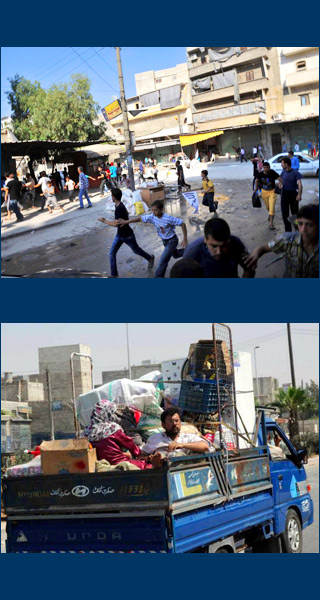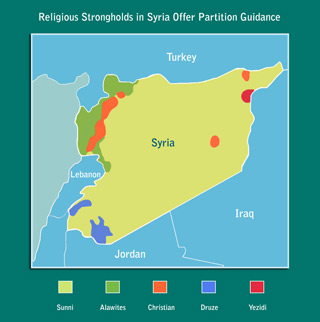Is Partition a Solution for Syria?
Is Partition a Solution for Syria?

LONDON: The Indian subcontinent is about 5000 kilometers away from the cockpit of the Middle East’s latest upheaval, but analysts would do well to examine the subcontinent’s recent history to gain insight into Syria’s intractable conflict. At its root, the Syrian imbroglio is a sectarian one, produced by a mix of age-old conflict between Sunnis and Shias, and an old imperialist policy of divide-and-rule. The 1947 partitioning of British India into India and Pakistan eased communal violence dramatically. And so Syria, too, could be on the way to a solution by partition.
Taking into account the intensity of violence, the level of the armed opposition’s organization and the duration of fighting, the International Committee of the Red Cross ruled on 15 July that a civil war is raging in Syria. Of the 23 million Syrians, 3 million are Alawites, a sub-sect within Shia Islam, with the Sunnis being 16 million strong.
The partition of British India was accompanied by roughly 1.5 million deaths and transfer of some 12 million people across the newly demarcated international border.
Whereas the longest conventional war in the past century between Iraq and Iran lasted nearly eight years, the civil war in Lebanon dragged on for more than 15 years. Unlike conventional armed conflicts between sovereign states, civil wars do not always end formally with a document cosigned by the warring parties.
Several scenarios for Syria fall into two categories: clear-cut and protracted. The most optimistic and least violent one has Syrian President Bashar al-Assad voluntarily relinquishing power in favor of a transitional authority headed by his deputy – following the example of Yemeni President Ali Abdullah Saleh last December – until fresh elections are held. This proposal has the backing of the United States, Britain and France, and would satisfy the Syrian opposition who refuse to deal with Assad under any circumstances.
Another clear-cut scenario would entail the regular Syrian military defeated by the opposition Free Syrian Army, or FSA. In theory, the FSA can achieve this by “controlled demolition” of the Assad regime, stripping it of one powerful layer after another, until it’s left with the exclusively Alawi militia nicknamed Shabiha – or ghosts. In practice, such a process rarely goes according to the plan, particularly when more than 100 rebel formations, lacking a central command and control, are fighting the government.
Such a multifarious coalition of anti-Assad groups, united only by their hatred of the Alawite-dominated regime, probably could not cope with the aftermath of the collapse of the centralized Baathist state. Even the US Pentagon, with its vast resources, backed actively by the anti–Saddam Hussein opposition, struggled to tackle the chaos that befell Iraq after the 2003 invasion.
The post-Assad period could witness ethnic cleansing of Alawites and their close allies, the Christians, and clashes among various anti-Assad armed militias for supremacy, with Al Qaeda– affiliated groups finding a rich ground to flourish as they did in the post–Saddam Hussein Iraq.

A protracted scenario is more likely. A study of how the unrest has escalated can aid forecasting the likely future. The initial peaceful protest, which started in March 2011, escalated into armed resistance in the face of brutal suppression unleashed by the regime. The fledgling FSA, fostered by Turkey and operating along the border with Syria, evolved into a fighting force, aided by weapons bought by Saudi Arabia and Qatar, and intelligence supplied by the spying agencies of Turkey, the US, Britain and France. By the middle of this year, rebel forces had set up bases in the countryside, large towns and certain neighborhoods of large cities such as Homs before launching attacks in Damascus and Aleppo.
Having recovered the neighborhoods in Damascus and its suburbs lost earlier to the rebels, regular forces are now fighting to expel their opponents from the southern and eastern sections of Aleppo, the largest city of Syria. The rebels, lacking an air force, have little chance of beating back the expected onslaught by loyalist troops.
The next phase will likely see the rebels focus on Daraa in the south, Deir al Zour in the east, the Homs-Idlib corridor in the northwest and rural areas around the two largest cities, Aleppo and Damascus. On the other side, regular security forces along with the Shabiha militia will tighten their grip on the population centers Aleppo and Damascus, and the coastal plain between the Alawiyin Mountains, running north to south, and the Mediterranean.
Among the half dozen Mediterranean ports, Latakia is the largest. And the second largest, Tartus, is the site of Russia’s sole naval base in the Mediterranean. By gradually shifting its power base to Latakia, the Assad regime could continue a protracted civil war with assistance from Iran and Russia.
The end of such conflict can be achieved by carving out an Alawite state wedged between Lebanon and Turkey. This could involve population exchange amid violence as happened in British India in 1947, with Hindus and Sikhs moving out of West Pakistan into East Punjab and Delhi, and the Muslims from East Punjab and Delhi migrating in the opposite direction.
Historically, it was in the interests of imperial Britain to accentuate traditional tensions between polytheistic Hindus and monotheist Muslims. In Syria, minority Alawites – a heterodox sub-sect within Islam shunned by majority Sunnis who were foremost in resisting French rule – were shored up by France during its Mandate over the territory from 1923 to 1941. Among other things, the French Mandate gave preference to Alawite applicants at their military academy in Damascus. Later when they moved the academy to Homs and set up Special Forces units, they continued the policy of preferential treatment to Alawites.
The Homs Military Academy played a major role after Syria's independence in 1946, with many of its predominantly Alawi graduates becoming generals and mounting a series of coups, the last one led by Hafiz Assad – native of Qurdaha, an Alawi village near Latakia – in 1971. He co-opted fellow cadet Mustafa Tlass, a Sunni, and showered his hometown of Rastan with public funds. While reserving top senior civilian and military posts for Sunnis, Hafiz Assad ensured that officer corps of the military, police and intelligence services were dominated by fellow Alawites.
After his death in 2000, Baher’s privatization policy enriched the Sunni business and industrial class in large cities, thus strengthening the regime’s non-Alawite base. But the sectarian composition of the Syrian armed forces did not change. Of 300,000 soldiers in the Syrian armed forces, about 100,000 are conscripts. Of 200,000 professional troops, 70 percent are Alawite, with the rest being mostly Sunni. As Alawites, these 140,000 soldiers know that if the Assad regime collapses, they could be butchered by Sunni victors. Many see no option to fighting for survival.
A viable alternative for them is retreat to an Alawite-majority zone where the Christians, who have allied closely with the Baathist regime, would be welcome. Together, the two minorities form a quarter of the Syrian population, just as the Muslims in British India did in the late 1940s.
There are overarching parallels between the British Raj in India and the French Mandate in Syria. In both cases, the imperial power promoted the minority, Muslims and Alawites, to counteract the nationalist movement led by the majority, Hindus and Sunnis. In the end, Britain conceded a homeland for Indian Muslims.
In Syria, a viable solution lies in partition.
Comments
You can't trust the highly institutionalized, academic religion based person. Academic people are the new religion. An old world based occupation of mostly old world humans. Passive aggressive tactics(academics) are taught through a superiority complex-Americanism! Did you know the first established mechanisms for re-education camps were founded before governments.....harvard-1600's.These old world institutionalizer's have been decipher ing, disseminating new world knowledge(science, sustainability, equality, technology, constitutional theory like articles of confederation, etc.) Well before any established government, the ivy league is in of itself, a religion designed to produce direct and indirect violent human pawns/proxies/minions/"citizens" in order to construct a,populace that would displace, murder, seek materialism, superficiality all in the name of the 1% or false belief systems(americanism, capitalism) like "governments/banks/corporations/religion-academia" these false belief systems are designed to manipulate, subjugate, oppress, and confuse(fascism) the masses.
Don't be surprised when the USA/Israel is directly behind the so called "partition" in order for "greater Israel" to take place. Blaming it on your opposition or controlled (Russia) opposition is obvious to free thinking humans!